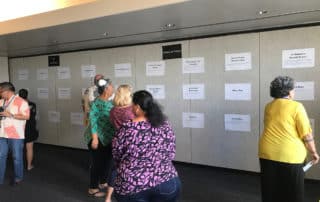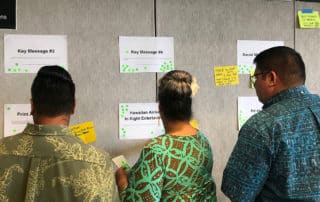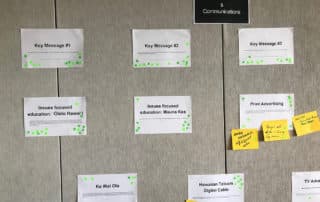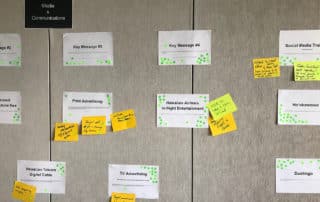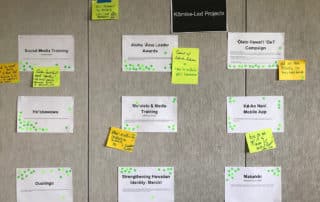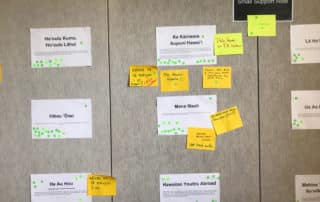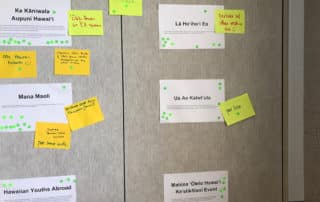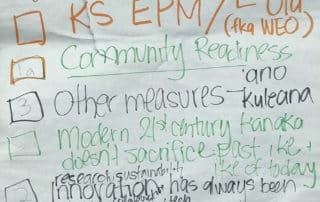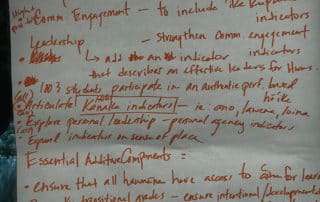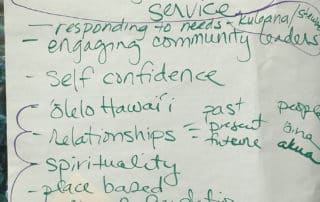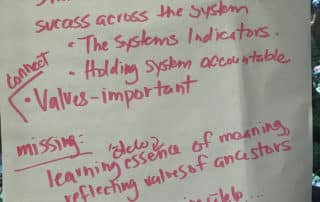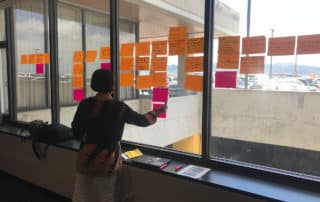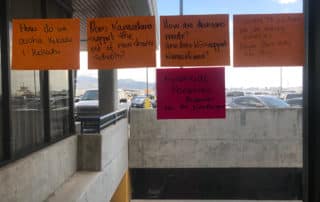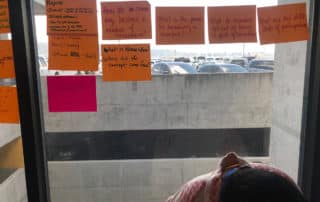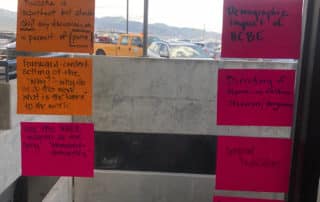| Hoʻolauna – Ke Welina, e nā lālā hou o Kanaeokana |
Kanaeokana participants welcomed new Kanaeokana members:
- Association of Hawaiian Civic Clubs, Sylvia Hussey
- Hāna High and Elementary, Richard Young, Vice Principal
- Molokaʻi HS, Dr. Katina Soares
- Lahainaluna HS, Lynn Kahoʻohalahala
- Ānuenue School, Leina‘ala Hall, Vice Principal
- Makahiki Athletic Association (MAA), member of the Inter-Kula Kōmike, Ikaika Fruen, Kaulana Noa
|
| Hoʻolauna – New Kealaiwikuamoʻo support staff |
New Kealaiwikuamoʻo staff members have been engaging in various efforts to forward Kanaeokana goals.
- Senior Project Manager, Makana Garma
- Principal Researcher, Dr. Liezl Houglum
|
| Kanaeokana FY17-18 efforts in review |
Participants reviewed short descriptions of the many Kanaeokana activities of the past year. They placed a green dot on those they wanted to “hana hou” going forward. Suggestions for growth and improvement were added with big Post-It notes. Folks felt a lot of satisfaction and pride in seeing how much was accomplished.
|
| Measuring progress: Identifying Kanaeokana impact indicators Kōmike Hoʻokele presentation |
The Kōmike Hoʻokele (in this activity, led by Olani Lilly) developed a presentation to consider collective impact shared measures:
- Conditions of collective impact
- Common agenda
- Mutually reinforcing activities
- Continuous communication
- Backbone support
- Shared measurements
- Kanaeokana well meets the first four conditions. However, it only has measures for specific kōmike work but not collective Kanaeokana work.
- Need to develop measures to gauge Kanaeokana success in growing aloha ʻāina leaders.
- International and US examples of collective impact efforts and their measures were described.
- Possible use of KS Educational Pathway Milestones (EMPs), revised to meet Kanaeokana perspectives and goals, may connect to impact indicator work.
|
| Impact indicators activity: Harvesting collective intelligence |
Everyone gathered participated in a process that engaged them in multiple 1:1 conversations, small group discussions about the what was learned, and a large group sharing about everyone’s answers to four focal questions as they relate to the proposed revised version of KS’ EPMs:
- Q: What indicator(s) connect to the work of your organization? How would you define one indicator from the perspective of your organization?
A: Hoʻokanaka indicators should be integrated into framework (e.g., place-based ʻike and community engagement) from early childhood through maturity.
- Q: What are the critical elements necessary to develop Aloha ʻĀina leaders and what role does your organization play in that work?
A: Foundation should be ʻōlelo, spirituality, cultural practice, serving and giving back to community. We need to build/shift lifestyles to support this foundation.
- Q: How does your organization define success? How do you measure success?
A: A pilina-built community that applies innovation to fulfilling kuleana. Need to consider 21st-century context of haumāna.
- Q: From your organization’s or Kanaeokana kōmike’s work, what elements connect to or are missing from the indicators?
A: Connections include ʻōlelo, culture, values. Puka include ʻohana, community, career, systems, birth to Pre-K all the way through to kupuna.
|
| Improving Kanaeokana efficacy: Why a Kanaeokana handbook? |
Three Kōmike Hoʻokele members (Keiki Kawaiʻaeʻa, Makalapua Alencastre, and Olani Lilly) and two Kealaiwikuamoʻo staff (Ryan Gonzalez and Kēhau Abad) went to a Collaborative Leadership training. They shared a brief presentation describing how what they learned relates to Kanaeokana:
- Attributes of highly successful 21st-century businesses and organizations include use of collaborative leadership models.
- Collaborative organizations include traits already present in Kanaeokana.
- An “even” landscape where no person or group is seen as “the boss”
- Where “work”, or for Kanaeokana, kuleana, is seen as “the boss”
- Where the organization includes lots of “T-shaped” people–those who have a broad area of knowledge (the horizontal part of the “T”) while also possessing a area of deep knowledge (the vertical part of the “T”).
- Where a group shares understandings and expectations that promote transparency.
- An area where the presenters thought Kanaeokana could improve is in a critical trait of collaborative organizations: Clarity.
- A key tool that the training suggested was to develop a member-driven, user-friendly, honest and “real” handbook.
|
| Engaging Kanaeokana participants in developing a Kanaeokana handbook: More harvesting of collective intelligence |
Everyone was asked to consider, jot down, and post their response to this querry:
- What questions would you want to have answered in the handbook? (jotted on orange paper)
After everyone had a chance to review the questions posted, They were then asked respond to this question:
- What answers would you wish to see offered in the handbook to the questions posed? (jotted on magenta paper)
|
| Hālauolōlo Kōmike presentation: Sharing strategic directions and proposals |
Hālauolōlo Kōmike members (Susie Osborne, Charlene Hoe, and Olani Lilly) shared a presentation outlining their kōmike’s strategic directions and specific proposals.
- High-level goals
- Establish a capital fund, Kaumaiʻeliʻeli to support facilities needs for Hawaiian focused charter schools (Phase 1) and other Kanaeokana entities seeking facilities (Phase 2).
- Establish a Kanaeokana endowment fund for Kanaeokana programmatic needs.
- Renaming of kōmike to tie to the moʻolelo of Kana, the namesake of Kanaeokana.
- Hālauolōlo: Inoa of kōmike, the inoa of Kana’s hālau waʻa that housed his waʻa, Kaumaiʻeliʻeli
- Kaumaiʻeliʻeli: Inoa of the Kana’s waʻa, created by his grandmother, Uli.
- Create efficiencies in jointly seeking facilities funding (so entities are not competing with one another but working in sync with one another).
- Primary attributes of envisioned facilities
- Kula as community centers
- Building designs and materials that embody sustainability
- Interiors that support 21st century and Hawaiian-grounded learning
- Replicable plans that can be used by many kula and organizations (providing economies of scale) but that are easily modified for the specific needs of any context
- To be advised by a panel of experts in a soon to be formed Advisory group named Iwikaʻele. This was the name of the steering paddle of Kaumaiʻeliʻeli.
- Goal: Create a fund of $10M by 2020
- Phase 1: Hawaiian focused charter schools
- Phase 2: Other Kanaeokana entities in need of facilities
|
| Discussion led by Hālauolōlo Kōmike: Gaining feedback on proposals presented |
The conversation provided much useful feedback for the kōmike, including an overall consensus of support for their plans. Following a robust discussion, the kōmike a used a “fist to five” gauge, which rendered largely “5” responses, and just a few “4” or “3” responses. More specific feedback included such comments as these:
- A needs assessment is a prerequisite — funders’ support hinges on this information, how funding will be distributed. (Kōmike and Hoʻolako Like staff are actively working on this.)
- How to generate funding — Is it possible to seek matching funders? Will the entity who is being helped be required to come up with matching funding?
- Composition of an advisory committee should include and investment manager and those looped into community development networks.
- There would be a need to work out common agreements on how money raised will be distributed. How do we organize ourselves strategically? How would a entity request support?
- We’re all fundraising for our own projects: How do we benefit the whole? We don’t want to undermine each other.
- How do we generate funds for immediate needs and support each other in larger efforts?
- Can we also think about going after in-kind support, especially for repairs and maintenance of facilities?. We need to build relationships with local construction companies.
- Make sure there is an opportunity for this process to be audited regularly to provide transparency, avoid conflict, ensure compliance.
|
| Kaʻao No Kana a me Nīheu (The Story of Kana and Nīheu): Deepening our understanding behind the name Kanaeokana |
Manaiakalani Kalua generously shared a detailed, moving, and hilarious rendition of the famous story of Kana and Nīheu and suggested we also read the ʻōlelo pālua version of this moʻolelo shared in Ulukau. Some big takeaways from the moʻolelo were that:
- Kana needed to be well-nourished and cared for to grow to fulfill his kuleana and destiny.
- That care primarily came from his grandmother, Uli, an akua whose deep ancestral, spiritual knowledge Kana relied upon regularly for guidance.
- Kana’s success was made possible by the aide of key partners, as with his brother Nīheu and their many supporters.
Keiki Kawaiʻaeʻa followed the moʻolelo with an explanation of the name Kanaeokana that she had offered, and which the group had chosen back in February 2017.
- A netting made of Kāna, an amazing kupua who could stretch and take varied forms to fulfill the many challenges he encountered
- An ever expanding net, able to grow to include more members, goals, and efforts over time
- A netting that inherently connects each node to one another ensuring cohesion and collective strength
- A nae, or fine-mesh netting that doesn’t allow things to slip away but that catches all that’s important.
- A nae, or finely crafted netting to serve as the foundation upon which something as beautiful and significant as an ʻahuʻula could be crafted.
|
| Zone of Innovation: Growing a Hawaiian culture-based math community of practice |
Kelly Broadus of Hoʻolako Like offered a presentation of a major project of the Hawaiian focused charter schools: Growing a Hawaiian culture-based math community of practice.
Kahua for the HCBE Math Community of Practice
- Problem of Practice: 75% of Native Hawaiian students are placed in remedial math in post-high education
- Theory of Change: Implementation of professional development to improve HCBE Math teaching and learning
- Community of Practice components
- Shared domain of interest – Hawaiian Culture-based Education Math
- Practitioners – learning from each other in a peer group by engaging in unit and lesson plan development and implementation; engaging in iterative processes to review and refine unit and lesson plan implementation; utilizing and reflecting on effectiveness of mathematical content area and mindset instruction instructional strategies
- Developing a shared practice over sustained time and interaction
- Essential Question: Ma hea e ola ai ka makemakika?
Summer 2018: 5 Week PD
- Created HCBE Math Definition
- Each kumu developed three (3) unit plans with 10 lessons per unit to be implemented over the course of the School Year 2018-2019
- Engaged in Mathematical Mindset professional development
Next Steps: SY18-19
- Implementation of three unit plans
- October and March professional development sessions
|
| Kōmike Hoʻokō (standing committees): Q/A and Sign-up |
An open time was saved at the end of the meeting to allow participants to engage in 1:1 conversations to learn more about the work of each of the six kōmike hoʻokō and to sign up to join any of them that interested them. |

